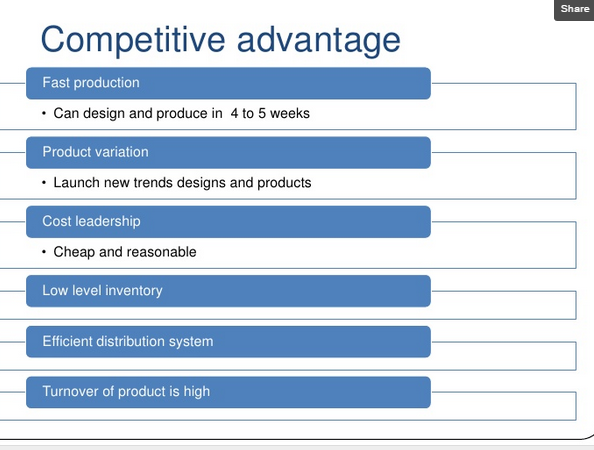ZARA has become Spain’s best known fashion brand and the
flagship brand of £2.5 billion holding group Inditex. In 40 years since it
began retailing clothes, it has emerged as one of the world’s fastest growing manufacturers
of affordable fashion clothing. However Zara’s success story lies in its unique
break through supply chain strategy by which it has differentiated itself from
its competitors.
Today’s consumers are spending less on clothing and more on
healthcare, electronics, leisure ,travel etc and they can choose from a wide
array of inexpensive products. Thus to capture today’s elusive consumer,
clothing giants need to find a breakthrough in the market.
Previously, the design and production process needed long
lead times of six months between the design of garment and delivery to
retailers which limited the abilities of manufacturers and retailers to satisfy
consumer demand. Zara has adopted the new business model which enabled short
lead times and restricted the design and distribution process to just 10 to 15
days . The firm chose to follow the strategy of captive outsourcing and
developed its own in house team designers which made clothing according to the
latest trends. It has shortened conventional supply chain
response from 5-7 month down to 2-2½ months and their customers are eagerly
awaiting next week’s new fashion.
Small and frequent
shipments keep product inventories fresh and scarce, forcing customers to
frequent the store often to buy the latest fashion clothes before they are sold
out. Owing to the twice weekly deliveries of replenishment stock as well as new
items, customers constantly return to stores to browse new items. Zara's global
average of 17 visits per customer per year is considerably higher than the
three visits to its competitors namely H&M, GAP, Banana Republic and
Forever 21.
Zara is essentially a vertically integrated retailer as it coordinates
all activities from its headquarters in La Curona in Spain which enables ZARA
to respond to consumer’s demand of the latest trends. This is an extra-ordinary strategy at a time
when “out-sourcing” is the hottest term in the industry.
Zara’s exerts control during the production process which is
a differentiating factor as compared to it’s competitors. New technologies
helped Zara adopt best production practices, warehouse procedures and stock
count systems. All this helped Zara to keep inventories low
The retail managers are the eyes and ears of the company
which provide word of mouth information on customer wants and preferences. Zara
as a whole from operational procedures to its office layout is designed to make
information flow as effectively as possible. Zara doesn’t have unnecessary
layers of bureaucracy which enables it to have a very fast response to fashion
and social blunders do not become financial burdens. For example if one or two
items do not sell they can be easily replaced by new trends since Zara produces
in small quantities and information from store managers is reported back every
day. This is quite at odds with relying solely on electronically collected
data, an approach used by competitors. A quick turn around on merchandise helps
generate cash, reduces inventories and eliminates the need for significant debt
Poor communication is
often the major culprit of bottlenecks. Zara invested in information technology
(IT) early on. Their in-house IT is simple and effective. Vendors and suppliers
report that people are accessible and answers can be obtained quickly. Internal
communication is maximized by housing on one floor, the designers, pattern
makers and merchandisers, as well as everyone else involved in getting the
product completed.
ZARA produces around 11,000 items, which are a lot of items
compared to many competitors, which produce around 2,000-4,000items. The “ZARA
concept” was developed in order for consumers to feel value, ZARA works by
satisfying the consumers need by shortening the clothing lifecycle.
It is an ongoing development where ZARA is constantly analyzing its
value chain and trying to attain control on as many sections as possible. As
mentioned above, ZARA differs from most apparel retailers because ZARA controls
almost every step of its supply chain. 50% of the products ZARA sells are
produced in-house, 26% in other countries in Europe and 24% in Asian countries.
The most high fashion clothes are made by ZARA in firm-owned factories in
Spain, while low-cost basic clothes are outsourced to Asian countries.
Research shows that combining high fashion with rapid
production works extremely well to induce sales oriented individual to buy
early. In fact, a firm's profits can spike up as much as 350% among this
die-hard group.
Fast fashion is not just good for retailers, say the
researchers, it's also good for consumers. "From a social point of view,
75% of the time fast fashion leads to greater overall welfare as people get a
premier item that they value highly. Because production times are short, they
get it when they need it. Plus, there's less overproduction and waste.
Thus Zara tries to maintain control over its entire supply
chain rather than outsourcing to China and some other countries where labor is
cheap whereas most companies in the fashion industry are firmly entrenched
in a business model that involves outsourcing production and distributing
products through cheaper, "slow boat" channels. However with the
minimum wages increasing and labor becoming more and more expensive in China,
will other manufacturers follow Zara’s vertically integrated supply chain?
Sources:
http://www.gsb.stanford.edu/news/research/swinney_fashion.html
http://www.diva-portal.org/smash/get/diva2%3A230949/FULLTEXT01.pdf
http://www.uniquebusinessstrategies.co.uk/pdfs/case%20studies/zarathespeedingbullet.pdf
http://www.gsb.stanford.edu/news/research/swinney_fashion.html
http://www.diva-portal.org/smash/get/diva2%3A230949/FULLTEXT01.pdf
http://www.uniquebusinessstrategies.co.uk/pdfs/case%20studies/zarathespeedingbullet.pdf



No comments:
Post a Comment
Note: Only a member of this blog may post a comment.